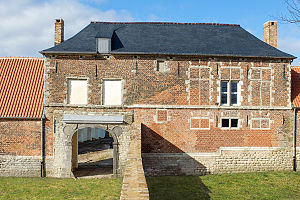Hougoumont
| Château d'Hougoumont | |
|---|---|
| Waterloo, Belgium | |

View of the Hougoumont farm from the south, showing the restored Game Keeper's Cottage and the gate on that side
|
|
| Site information | |
| Owner | Intercommunal cooperative society "Bataille de Waterloo 1815" |
| Condition | under reconstruction |
| Site history | |
| Built | Between 1358 and 1474 |
| Built by | Order of St. John of Jerusalem (the Knights of Malta) |
| Materials | sandstone and red brick |
| Battles/wars | Battle of Waterloo |
| Garrison information | |
| Occupants |
|
Château d'Hougoumont (originally Goumont) is a large farmhouse situated at the bottom of an escarpment near the Nivelles road in Braine-l'Alleud, near Waterloo, Belgium. The escarpment is where British and other allied forces faced Napoleon's Army at the Battle of Waterloo on 18 June 1815.
Hougoumont, which had become dilapidated, was fully restored in time for the 200th anniversary of the battle and opened to the public on 18 June 2015.
The name is from Germanic Hauha-berg. The whole of Brabant was once Dutch speaking. Hauha- means "high", and berg means "mountain" (as in iceberg). The name of the farm was later pronounced Honberg, Honsberg, and even Gomberg. The Belgian francophones kept hauha, changed it into hougou and translated berg into mont, obtaining Hougoumont. Note that this mont is a low hill.
According to Sir Walter Scott who visited the battlefield in January 1816, "Hougoumont (a name bestowed, I believe, by a mistake of our great commander [Wellington], but which will certainly supersede the more proper one of Chateau-Goumont) is the only place of consideration which was totally destroyed".
In 1474 the Order of Saint John (later to become the Order of Malta) bought 30 acres (0.12 km2) of forest, Le Goumont, and another 30 acres (0.12 km2) of adjacent heathland for 100 golden crowns. The deed of sale did not mention any building on the grounds.
A building had apparently been erected on the land as it was sold in 1536 to Pierre du Fief, attorney-general to the Council of Brabant, who subsequently enlarged the property considerably. In 1562 the estate became the property of Pierre Quarré and stayed in the Quarré family until 1637 when it was bought by Arnold Schuyl, Lord of Walhorn. It was around this time that the present building was erected.
...
Wikipedia
